
Veterans, service members and guests arrive at the USS Arizona Memorial for the Shrine Room Wall dedication ceremony. The Shrine Room Wall serves as a headstone for the 1,177 men who died aboard the USS Arizona during the Dec. 7, 1941, attack on Pearl Harbor. US Navy photo by Mass Communication Specialist 2nd Class Diana Quinlan.
When Ken Potts began his morning on Dec. 7, 1941, he expected to enjoy a day ashore, away from his duties as a sailor aboard the USS Arizona. But a few minutes before 8 a.m., he heard a disconcerting noise. What happened over the course of the next few hours not only changed his Sunday plans, it changed the trajectory of his entire life.
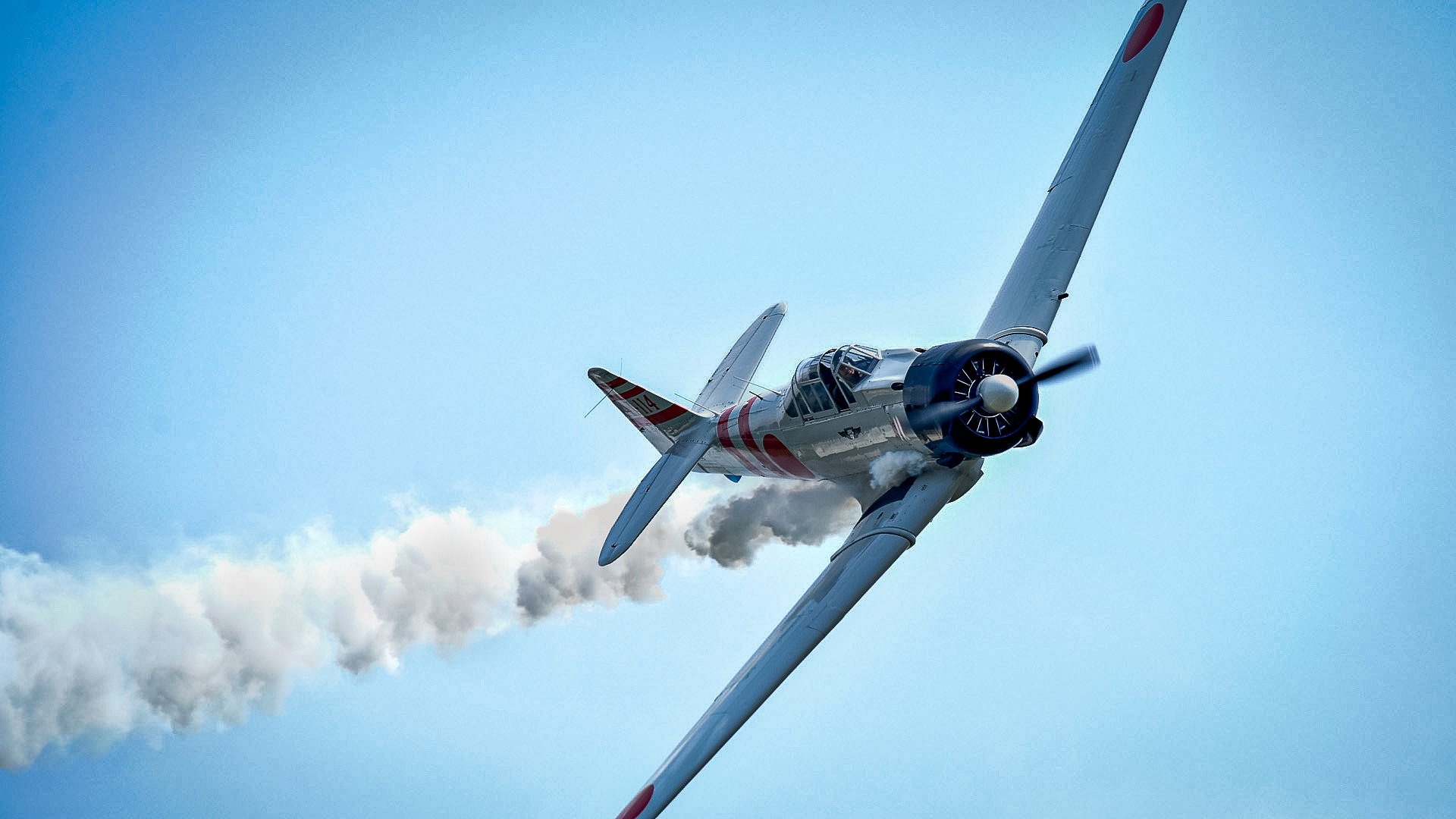
A Japanese Mitsubishi A6M Zero aircraft performs as part of the "Tora! Tora! Tora!" performance during the Wings Over Wayne Air Show, May 21, 2017, at Seymour Johnson Air Force Base, North Carolina. US Air Force photo by Airman 1st Class Christopher Maldonado.
Loud speakers across Pearl Harbor sounded the alarm, calling all sailors to report to their respective ships’ general quarters. Potts flagged down the first passing car and climbed inside with eight other sailors. A few minutes later he was back on the fantail of the already-burning Arizona. Before Potts could get to his battle station, a fourth armor-piercing bomb hit the ship, punching through the Arizona’s fortified deck. It detonated in the main magazine, causing a massive explosion that nearly ripped the 608-foot battleship in half.
In an interview for American Veterans Center 79 years later, as one of only two remaining survivors from the Arizona, Potts recalled the attack’s lasting effects on his psyche.
“For a long time, even after I got out of the Navy, if I was anywhere out in the open and heard a siren, I’d start to shake,” Potts said.
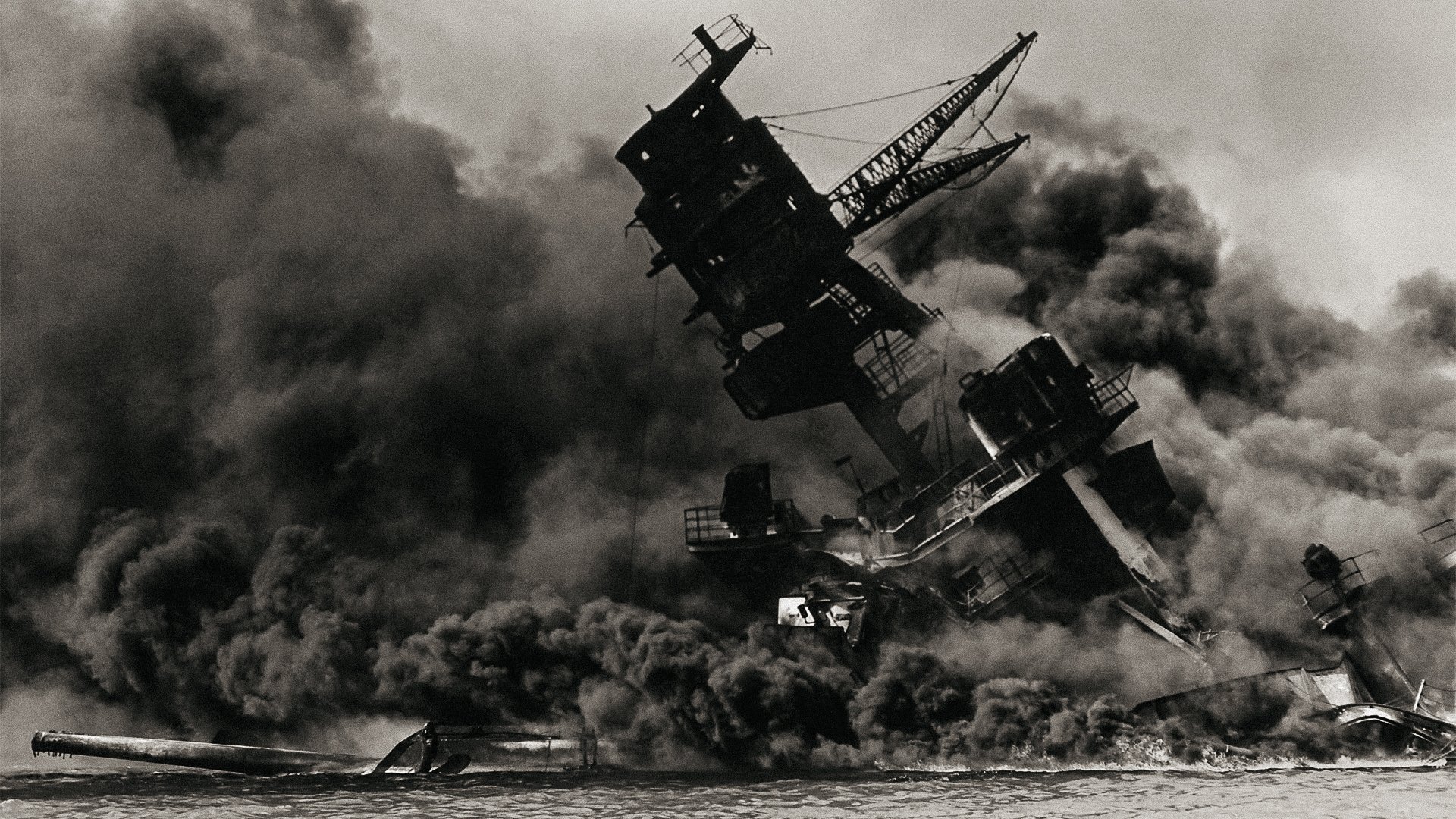
The USS Arizona (BB-39) burning after the Japanese attack on Pearl Harbor, Dec. 7, 1941. Photo courtesy of Wikimedia Commons.
The Arizona is unique among America’s World War II battleships. For one, it was never salvaged. Today, the wreck remains visible, just 40 feet below the water’s surface. In 1962, a memorial to those killed in the attack was built on top of the sunken ship. The names of every sailor and Marine who died on the Arizona are etched into the white marble walls. Below, their remains are entombed inside the submerged hull.
Related: The Most American Moment of Pearl Harbor: Sailor Took On Japanese in Full Football Pads
Before World War II
Commissioned in October 1916, the USS Arizona (BB-39) was the second and last ship of the Pennsylvania class of battleships. It remained anchored in Norfolk, Virginia, until 1919 when it sailed to France for the Paris Peace Conference. Then in 1921, the Arizona was transferred to the Pacific Fleet. It spent the majority of the next two decades working out of California. In 1940, the entire Pacific Fleet relocated to Hawaii, where it was based at Pearl Harbor in an effort to deter Japanese expansion.
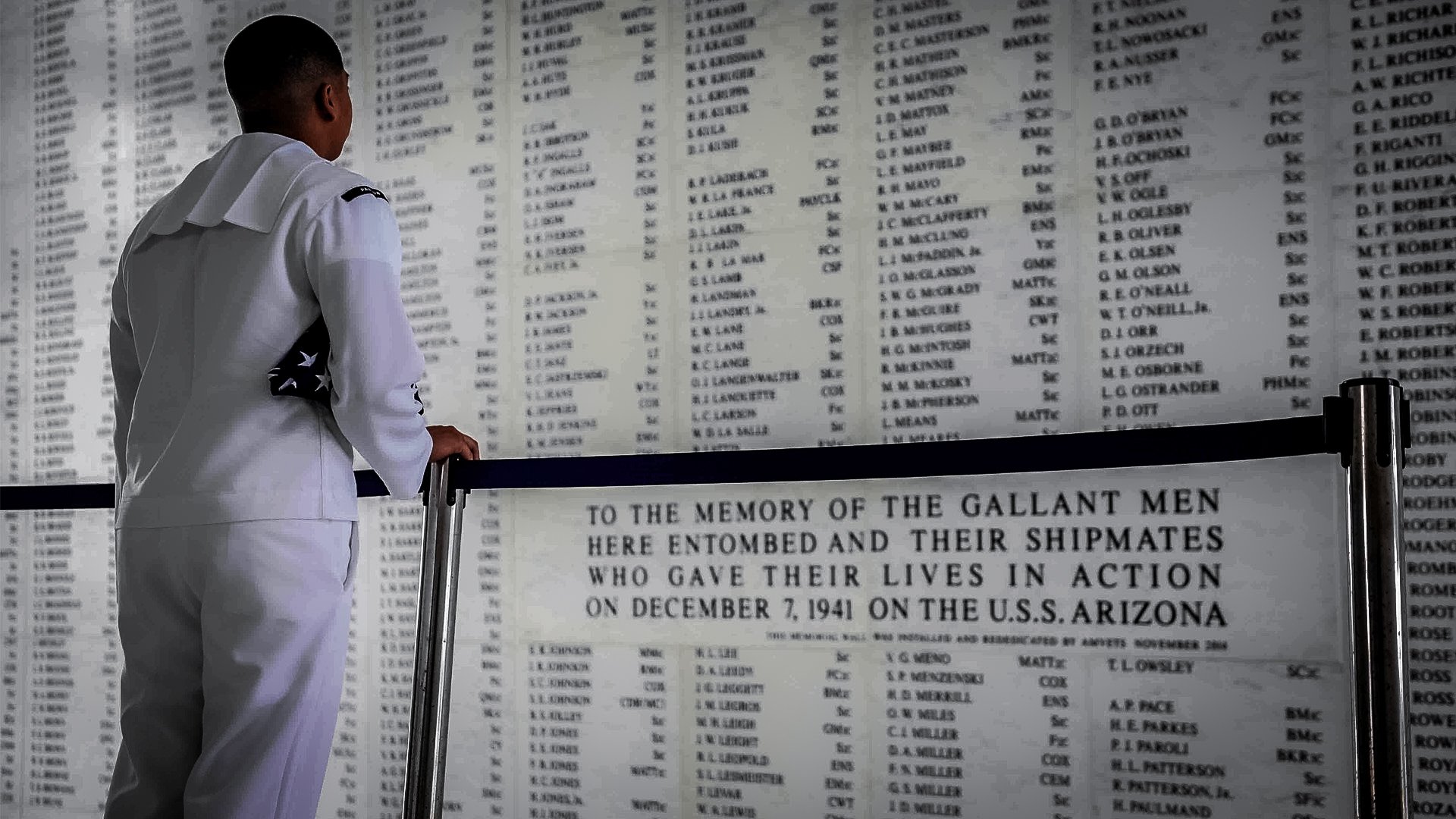
Yeoman 2nd Class Christopher Buco, assigned to the "Golden Eagles" of Patrol Squadron (VP) 9, reads the list of fallen military members following colors onboard the USS Arizona Memorial in Pearl Harbor, Hawaii. US Navy photo by Mass Communication Specialist 3rd Class Amber L. Porter.
The Arizona was a mammoth among 20th-century warships. It was one of the most heavily armed and armored battleships in the US Navy. Arizona sported 12 14-inch guns; 22 5-inch guns; four 3-inch anti-aircraft guns; and two underwater torpedo tubes, each carrying 24 torpedoes. Its deck was reinforced with specially treated steel, and an anti-torpedo bulge was added to the ship’s hull. Below the waterline, the Arizona was also upgraded with a double bottom — twice as much armor as standard warships. The massive battleship was designed to withstand a blast equalling up to 300 pounds of TNT without suffering significant damage.
Related: Portrait of a Ship: USS Abraham Lincoln
A Date Which Will Live in Infamy
On Dec. 7, 1941, the Arizona’s formidable armor was put to the test. At 7:48 a.m., the first wave of Japanese aircraft commenced their surprise attack on Pearl Harbor. Over the next 75 minutes, 353 Japanese aircraft launched from six aircraft carriers dropped bombs and torpedoes, and strafed the Pacific Fleet. Seven battleships were moored side-by-side next to Ford Island, in what became known as battleship row. The easy targets suffered considerable damage, but none was so catastrophically mangled as the Arizona.
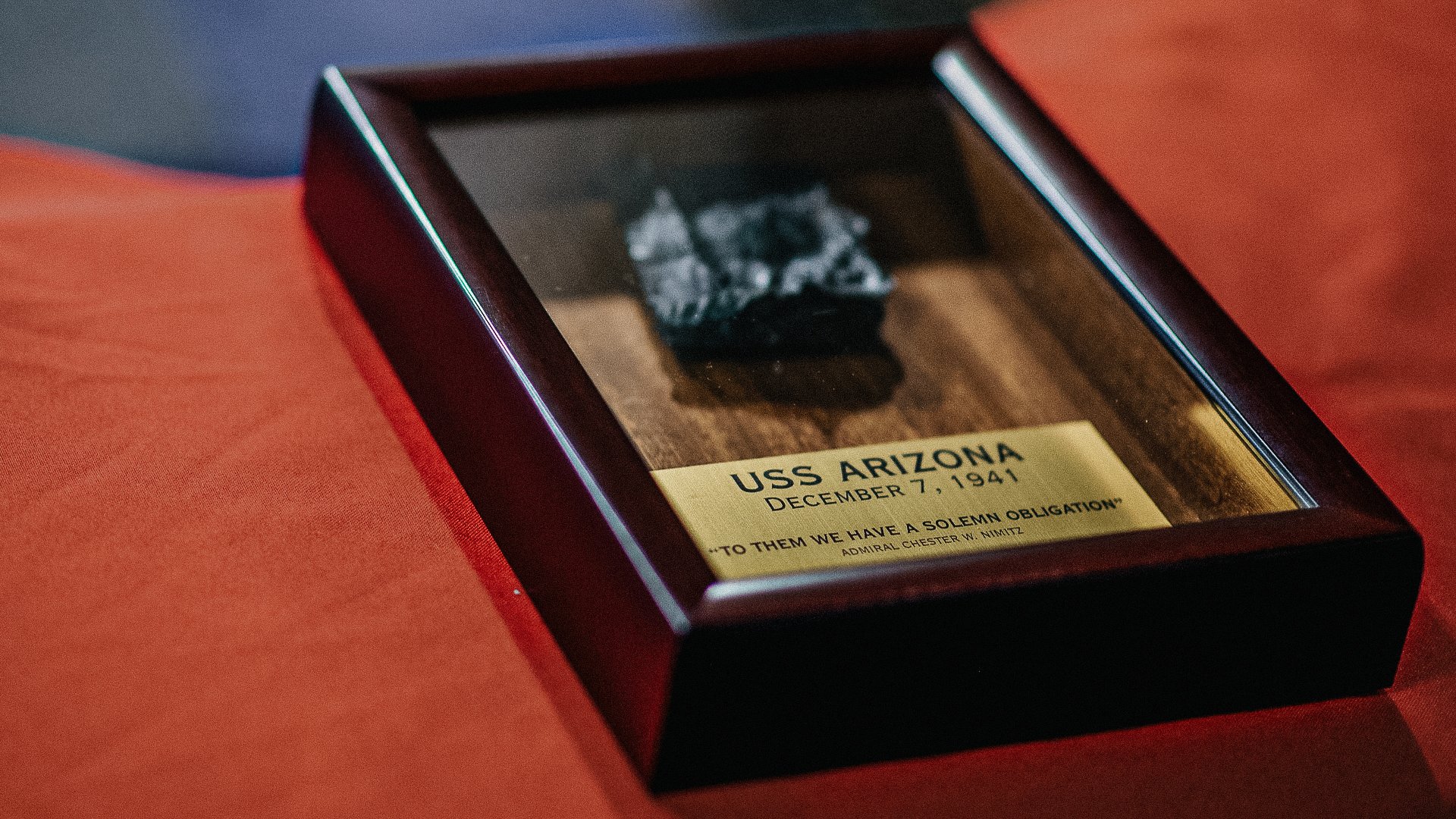
Relic from the USS Arizona (BB-39) presented to the crew of the aircraft carrier USS Nimitz (CVN 68) in remembrance and commemoration of the 80th anniversary of the attack on Pearl Harbor. The relic originates from a section of the superstructure of the Arizona that was removed from the ship when the Arizona Memorial was constructed. US Navy photo by Mass Communication Specialist Seaman Hannah Kantner.
During the first 10 minutes of the attack, the Arizona was struck by three armor-piercing bombs. The ship’s captain, Franklin Van Valkenburgh, remained on the bridge where he continued to command the crew in spite of the inherent danger. The division commander, Rear Adm. Isaac Campbell Kidd, joined Valkenburgh on the bridge of the Arizona to better survey the scale of the ongoing attack. Both officers refused to abandon their post and were killed when a fourth bomb punctured the ship’s deck and detonated the forward magazine. They were posthumously awarded Medals of Honor.
The ship’s damage control officer, Samuel Fuqua, was knocked unconscious by the first bomb to hit the Arizona. When he regained consciousness he immediately commenced overseeing fire fighting and rescue efforts. For his actions, he became the second member of the Arizona to receive the Medal of Honor.

The battleship USS Arizona (BB 39) memorial in 2018. US Navy photo by Mass Communication Specialist 1st Class Arthurgwain L. Marquez.
When the Arizona sank to the bottom of Pearl Harbor, it took 1,177 crew members with it — roughly half of those killed in the attack.
In total, the Japanese damaged or sank 21 ships, including eight battleships, four destroyers, and three cruisers. Following the attack, the Navy — bolstered by civilian divers — began salvage operations. In less than six months, five battleships and two cruisers were refloated, repaired, and returned to service. The Arizona was deemed too badly damaged and was left where it sank.
Related: Profile of a Ship: USS Carl Vinson
Pearl Harbor National Memorial
It has been nearly 82 years since the Japanese attacked the United States and sank the Arizona. Today the ship is still visible from the Pearl Harbor National Memorial. The memorial is run by the National Park Service and includes the Arizona, the USS Bowfin, and the Battleship Missouri. With a free reserved ticket, patrons can also take a Pearl Harbor tour that includes access to the Pearl Harbor aviation museum, Pearl Harbor visitor center, and the Arizona memorial.
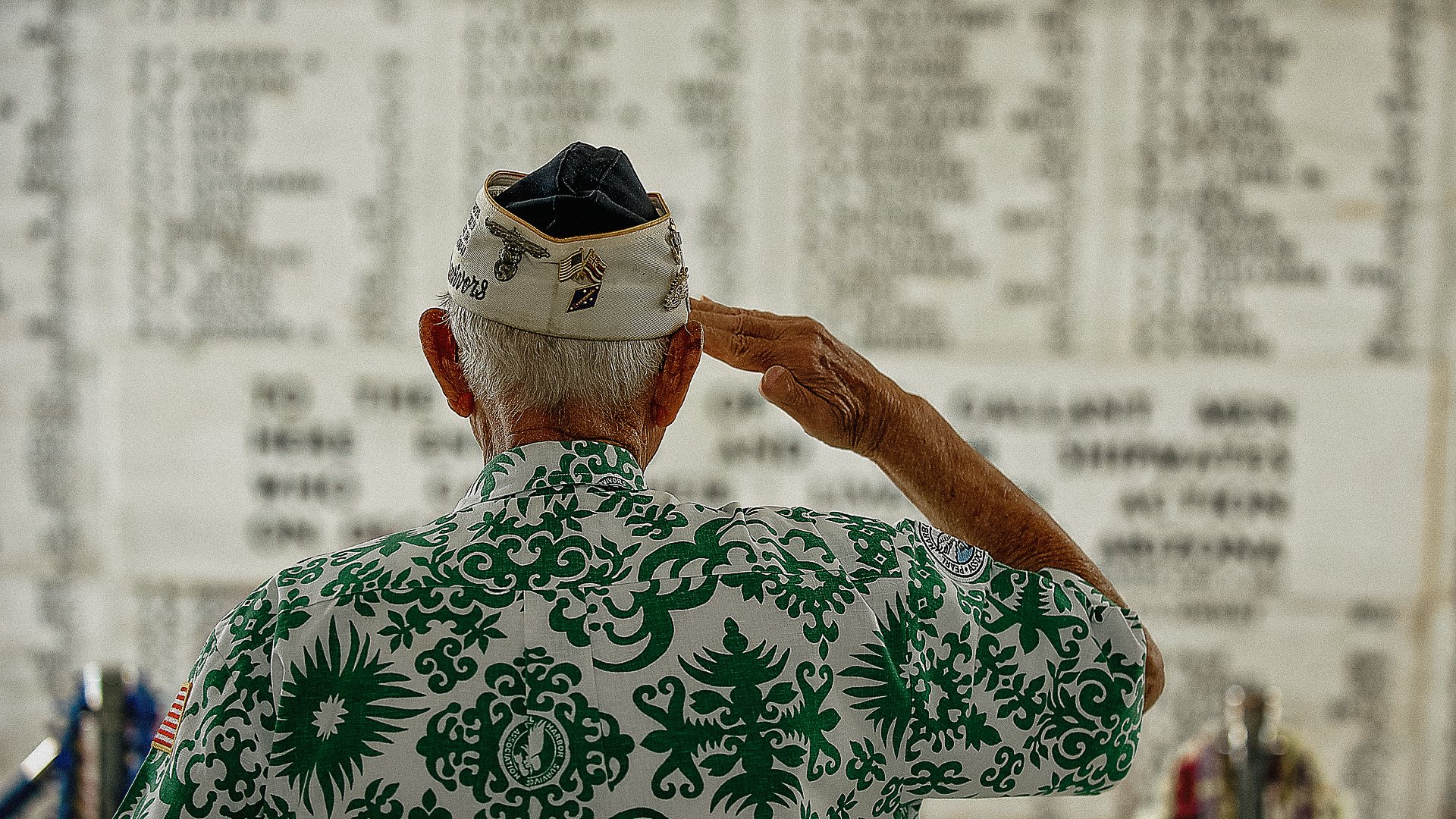
Retired US Army Command Sgt. Maj. Sterling R. Cale, 90-year-old Pearl Harbor survivor, takes a moment in the shrine room of the USS Arizona Memorial to honor the 1,177 service members who lost their lives during the attack on the USS Arizona Dec. 7, 1941. Since its construction, the memorial has stood as a place to remember the tragedy and honor the dead. US Air Force photo by Tech. Sgt. Michael Holzworth.
Two original Arizona bells were salvaged from the wreckage. Each bell weighs 1,820 pounds and were once used to mark time and communicate with other vessels. One is currently on display at the USS Arizona memorial. The other is at the University of Arizona and is rung after every home football victory.
The Arizona is one of the most frequently visited locations in Hawaii, averaging 4,000 visitors every day. It stands as a somber reminder of the sacrifice of the 2,403 Americans killed during the attack on Pearl Harbor.
Read Next: Profile of a Ship: USS North Carolina

Mac Caltrider is a senior staff writer for Coffee or Die Magazine. He served in the US Marine Corps and is a former police officer. Caltrider earned his bachelor’s degree in history and now reads anything he can get his hands on. He is also the creator of Pipes & Pages, a site intended to increase readership among enlisted troops. Caltrider spends most of his time reading, writing, and waging a one-man war against premature hair loss.
BRCC and Bad Moon Print Press team up for an exclusive, limited-edition T-shirt design!
BRCC partners with Team Room Design for an exclusive T-shirt release!
Thirty Seconds Out has partnered with BRCC for an exclusive shirt design invoking the God of Winter.
Lucas O'Hara of Grizzly Forge has teamed up with BRCC for a badass, exclusive Shirt Club T-shirt design featuring his most popular knife and tiomahawk.
Coffee or Die sits down with one of the graphic designers behind Black Rifle Coffee's signature look and vibe.
Biden will award the Medal of Honor to a Vietnam War Army helicopter pilot who risked his life to save a reconnaissance team from almost certain death.
Ever wonder how much Jack Mandaville would f*ck sh*t up if he went back in time? The American Revolution didn't even see him coming.
A nearly 200-year-old West Point time capsule that at first appeared to yield little more than dust contains hidden treasure, the US Military Academy said.












